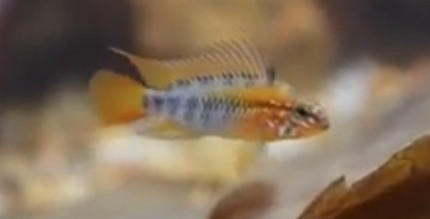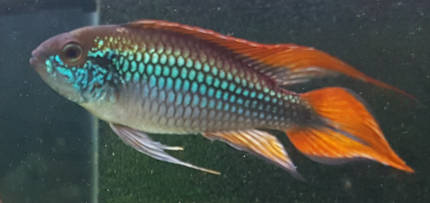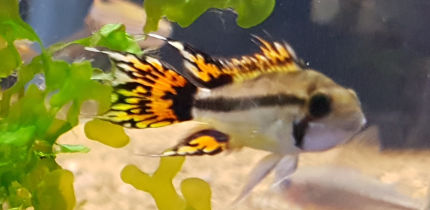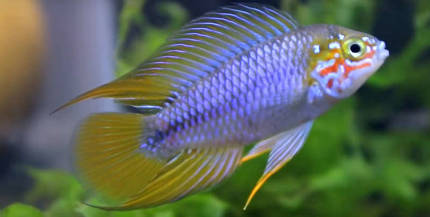About Apistogramma Macmasteri
Apistogramma Macmasteri (also known as Macmaster's Dwarf Cichlid) is a captivating freshwater fish found in the parts of Venezuela and Colombia.
Males showcase vibrant oranges, blues, and reds. Females possess a subtler elegance in shades of beige and pale yellow. Both genders display intricate fin patterns and iridescent scales that shimmer in changing light.
Known for their fascinating behaviours, they thrive in planted tanks with hiding spots.
Apistogramma Macmasteri's dynamic colours and engaging behaviours make them a great addition to aquariums.
Apistogramma Macmasteri Profile
Origin: Parts of Venezuela and Colombia including upper Río Meta system and upper Rio Orinoco drainage.
Size: Female: up to 2 inches (5 cm), Male: up to 2.5 inches (6 cm).
Minimum tank size: 20 gallons (75 litres).
Tank region: Bottom half of the tank.
Water temperature:75 - 82 °F (24 - 28 °C)
Water conditions: PH between 5 to 7 is desirable. Soft water with a low TDS is preferred. Commercial bred varieties are less fussy.
Difficulty to keep: Beginner to intermediate level
Apistogramma Macmasteri Natural Habitat
Apistogramma Macmasteri is native to the Amazon River basin in South America. Specifically, they have been found in the Río Guaytiquía and Río Metica basins, upper Río Meta system, Colombia, and the upper Rio Orinoco drainage, which spans parts of Venezuela and Colombia.
Their natural habitat is characterized by the complex variety of water bodies within the rainforest ecosystem. These dwarf cichlids are commonly found in slow moving streams, and flooded forest areas, where the water is often clear and sheltered by lush vegetation.
Apistogramma Macmasteri are well adapted to these habitats, which typically feature submerged branches, tangled root systems, and dense aquatic plants. They seek refuge among these structures, using the vegetation as cover to evade predators and protect their territory.
The aquatic plants and submerged leaf litter offer not only protection but also provide foraging opportunities as they scavenge for small insects, and other foods.
Water conditions in their natural habitat tend to be soft and slightly acidic, with temperatures ranging between 75 to 82°F (24 to 28°C) .
Apistogramma Macmasteri have evolved to thrive in such diverse and intricate ecosystems. Understanding their natural habitat is essential for replicating suitable conditions in the aquarium. Recreating their natural habitat including appropriate water parameters, and offering hiding spots by arranging plants, rocks and wood in the aquarium setup will help ensure your Apistogramma Macmasteri feel at home and are not stressed.
Behaviour and Personality
Apistogramma Macmasteri exhibit captivating personality and behaviour that make them popular among aquarium enthusiasts. These fish are known for their intriguing social dynamics and vivid displays.
They are relatively peaceful compared to some other cichlid species, but they can still exhibit territorial behaviours, especially during breeding. Males often establish and defend small territories, where they court females and protect their chosen spawning site.
Their interaction with each other and other tank mates is fascinating to observe. They engage in courtship rituals, showcasing vibrant colours and intricate fin displays. During breeding, males become even more vibrant and flamboyant to attract females.
One notable behaviour is their ability to adapt their colours and patterns according to their mood and environment. This trait allows them to communicate and signal their emotions to other fish, adding an extra layer of interest to their behaviour.
In community tanks they do best when given ample hiding places and structured territories. Providing plants, caves, and driftwood mimics their natural habitat and encourages their natural behaviours.
Overall, the captivating personality and behaviour of Apistogramma Macmasteri make them a fantastic addition to aquariums.
Apistogramma Macmasteri Male vs Female
Males
Males are more colourful with vibrant hues that range from fiery oranges and intense blues to radiant reds and electric yellows. Their dorsal and caudal fins are elongated resulting in unique fin extensions.
During courtship and displays of dominance, males show off vibrant colours and intricate fin patterns to capture attention.
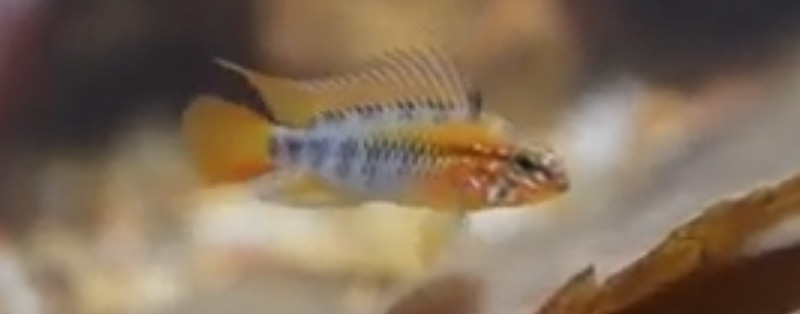
Females
Females are less colourful. They showcase a more muted colours of beige and pale yellow, allowing them to blend seamlessly into their natural surroundings.
What to feed Apistogramma Macmasteri
Feeding Apistogramma Macmasteri requires a well-rounded and varied diet to support their health and natural behaviours.
As omnivorous fish, they thrive on a mix of both animal and plant-based foods. High-quality pellets or flakes designed for tropical fish can serve as a staple diet, providing essential nutrients. However, to replicate their natural diet it is highly recommended to supplement their diet with live or frozen foods.
Feeding live or frozen options like brine shrimp and bloodworms will mimic their natural diet and encourage their natural foraging habits. These protein-rich live foods not only provide essential nutrients but also stimulate their hunting instincts.
For more information on what to feed you Apistogrammas see our article Best Foods For Apistogrammas.
It is recommended to feed small portions multiple times a day as they only have small stomachs and can only eat so much at a time. Overfeeding can lead to health issues and water quality problems.
By providing a balanced diet, you support the health, vivid colours, and engaging behaviour of your Apistogramma Macmasteri.
Apistogramma Macmasteri Aquarium Setup
Tank Size
To keep a pair of Apistogramma Macmasteri a minimum tank size of 20 gallons (75 litres) is recommended, this would also allow for some tank mates, such as tetras. Refer to below tank mates section.
However it is important to ensure the tank is setup appropriately in order to minimises any possible aggression.
If you plan to have a community tank, then generally the larger the tank the better.
Substrate
In the wild Apistogramma Macmasteri inhabit slow moving waters which refularly have a sandy bottom, hence I recommend a sand substrate.
Aquarium Layout
Apistogramma Macmasteri appreciate some hiding places within the aquarium and objects which break up line of sight. This can be achieved by adding driftwood, rocks, and plants to the aquarium in a way which mimics their natural environment.
These separated areas of the aquarium also provide separate territories should males get aggressive such as during breeding.
For more information on managing aggression see - Apistogramma Aggression And How To Reduce It.
Apistogramma Macmasteri Tank Mates
Other non aggressive fish are best. It is also worth considering which level (top middle or bottom) of the water column other fish swim so that you do not overcrowd the bottom of the aquarium which is where Apistogrammas like to inhabit.
Tetras such as Ember Tetras, Loreto Tetras (and many more), as well as Dwarf Pencilfish are generally good choices.
Generally Apistogrammas appreciate some tank mates, even just a small school of tetras to serve as dither fish will help then feel more secure.
For more detail on selecting appropriate Apistogramma tank mates check out our detailed article, Apistogramma Tank Mates.
Breeding Apistogramma Macmasteri
Breeding Apistogramma Macmasteri can be a rewarding but challenging process.
Below provides a summary of steps to breed Apistogramma Macmasteri further details and tips can be found in How To Breed Apistogramma Agassizii guide where the advice applies to most Apistogramma species including Macmasteri.
-
Select a Breeding Pair
To start breeding you will obviously need a Male and a Female who are in good health and sexually mature. Apistogramma are usually sexually mature by the time they are 6 months old.
-
Breeding Tank Setup
As a minimum I recommend a 20 gallon tank provides enough room should the pair start to get aggressive and need a hiding place or two.
Provide hiding spots and potential spawning sites by adding a cave rocks and driftwood. Java moss is a good plant to include, as well as providing hiding spots it is home to micro organisms which can provide a source of food to young fry.
-
Water Chemistry
Ensure water parameters are appropriate this means soft slightly acidic water with a ph between 5 and 6.5 for breeding.
-
Conditioning
The pair should be conditioned for breeding, this means ensuring that they are both strong and healthy.
To get your Apistogramma Macmasteri pair in good condition for breeding I recommend feeding high protein live foods such as brine shrimps.
-
Breeding Behaviour & Courtship
The male will initiate courtship by displaying vibrant colours and perform fin movements and displays to attract the female. When ready to spawn the female will become a much brighter yellow and will sometimes show her belly to the male as a sign that she is ready to breed.
-
Spawning
Occurs with the female laying eggs on the wall of the cave, gaps between rocks or similar location. The male will follow swimming over the eggs and fertilising them, this continues until the female has laid all her eggs.
-
Egg Care
The female guards the eggs while the male patrols the territory. The eggs usually hatch within a few days, and the parents continue to protect them.
-
Raising Fry
Once the fry (baby fish) hatch, they will cling to surfaces around the spawning site. At this point, you can feed them infusoria or microworms. Gradually introduce more suitable foods as they grow.
-
Parental Care
The female will continue to protect the fry while the male may continue to defend the territory. Keep in mind that parental care behaviour can vary. At this stage it is sometimes necessary to remove the male.
-
Free Swimming Fry
Once the fry are free-swimming and independent, they can be separated from the parents this will prevent any aggression or cases of the parents eating the fry. At this stage I recommend feeding baby brine shrimp.
For more information on feeding fry I recommend our Best foods for raising baby fish article.
Note with new Apistogramma pairs it can take a few goes for them to be successful. On the first occasions they may eat the eggs if they get spooked or maybe the eggs do not get fertilised.
Be patient they will most likely soon spawn again and after a couple of attempts be successful.
Conclusion
Apistogramma Macmasteri are a colourful dwarf cichlid with an interesting personality which can add a real spark and focal point to an aquarium.
They can be rewarding to breed, although some patience is required.
You may also find our article Apistogramma Dwarf Cichlid - The Ultimate Care Guide useful for further information about keeping Apistogrammas.
